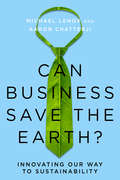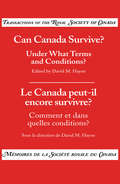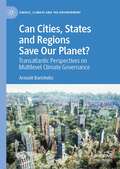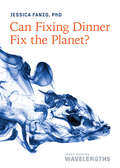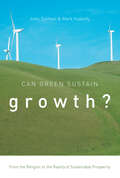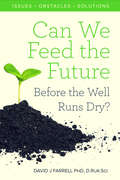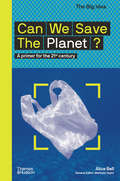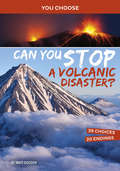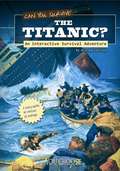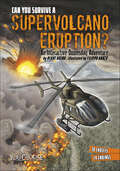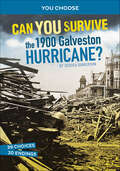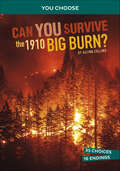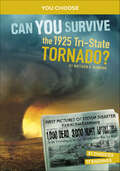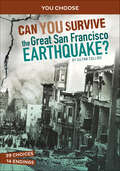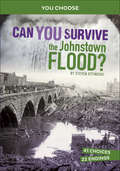- Table View
- List View
Camping with the President
by Ginger WadsworthShows how, while on a camping trip in 1903 with world-famous naturalist John Muir in Yosemite National Park, President Theodore Roosevelt formed his position on conservation, deciding to set aside new national parks and monuments to preserve wilderness lands for future generations.
Can Business Save the Earth?: Innovating Our Way to Sustainability
by Aaron Chatterji Michael LenoxIncreasingly, business leaders are tasked with developing new products, services, and business models that minimize environmental impact while driving economic growth. It's a tall order—and a call that is only getting louder. In Can Business Save the Earth?, Michael Lenox and Aaron Chatterji explain just how the private sector can help. Many believe that markets will inevitably demand sustainable practices and force them to emerge. But Lenox and Chatterji see it differently. Based on more than a decade of research and work with companies, they argue that a bright green future is only possible with dramatic innovation across multiple sectors at the same time. To achieve this, a broader ecosystem of players—including inventors, executives, customers, investors, activists, and governments—all must play a role. The book outlines how and the extent to which each group can serve as a driver of green growth. Then, Lenox and Chatterji identify where economic incentives currently exist, or could exist with institutional change, and ultimately address the larger question of how far well-coordinated efforts can take us in addressing the current environmental crisis.
Can Canada Survive?
by David M. HayneCanada is facing a critical period in its history. The Royal Society of Canada believed it had the responsibility to instigate both deep reflection and debate within the vast and diverse intellectual network it represents throughout Canada. In November 1996, the Fellows of all three Academies of the Society gathered to discuss perspectives on Canada's future.
Can Cities, States and Regions Save Our Planet?: Transatlantic Perspectives on Multilevel Climate Governance (Energy, Climate and the Environment)
by Arnault BarichellaThis book examines the potential for cities, states and regions to take decisive action on climate change at the local level. Local action constitutes an essential component of global efforts to keep temperatures below the 2°C Paris Agreement threshold. Focusing on three green municipal leaders - New York, Boston and Paris - this volume examines their multilevel interactions with higher governance echelons in the United States and France. Even though these countries are located on different continents, similar patterns emerge on both sides of the Atlantic. This book explores the key role of municipalities and sub-state entities in shaping the climate policy agenda vis-à-vis national governments in the US and France. It argues that inadequate articulation of multilevel governance may jeopardize efforts to limit global temperature increase below the 2°C threshold by the end of the century.
Can Fixing Dinner Fix the Planet? (Johns Hopkins Wavelengths)
by Jessica FanzoHow can consumers, nations, and international organizations work together to improve food systems before our planet loses its ability to sustain itself and its people?Do we have the right to eat wrongly?As the world's agricultural, environmental, and nutritional needs intersect—and often collide—how can consumers, nations, and international organizations work together to reverse the damage by changing how we make, distribute, and purchase food? Can such changes in practice and policy reverse the trajectories of the biggest global crises impacting our world: the burden of chronic diseases, the consequences of climate change, and the systemic economic and social inequities that exist within and among nations?Can Fixing Dinner Fix the Planet? is a clarion call for both individual consumers and those who shape our planet's food and environmental policies that:• describes the often destructive path that foods take from farms and seas through their processing, distribution, marketing, purchasing and waste management sites• explores the complex web of factors impacting our ability to simultaneously meet nutritional needs, sustain biodiversity and protect the environment• raises readers' food and environmental literacy through an engaging narrative about Fanzo's research on five continents along with the work of other inspiring global experts who are providing solutions to these crises• empowers readers to contribute to immediate and long-term changes by informing their decisions in restaurants, grocery stores, farmers markets, and kitchens
Can Green Sustain Growth?: From the Religion to the Reality of Sustainable Prosperity
by John Zysman Mark HubertyGreen growth has proven to be politically popular, but economically elusive. Can Green Sustain Growth? asks how we can move from theoretical support to implementation, and argues that this leap will require radical experimentation. But systemic change is costly, and a sweeping shift cannot be accomplished without political support, not to mention large-scale cooperation between business and government. Insightful and timely, this book brings together eight original, international case studies to consider what we can learn from the implementation of green growth strategies to date. This analysis reveals that coalitions for green experimentation emerge and survive when they link climate solutions to specific problems with near-term benefits that appeal to both environmental and industrial interests. Based on these findings, the volume delivers concrete policy recommendations for the next steps in the necessary shift towards sustainable prosperity.
Can I Recycle This?: A Guide to Better Recycling and How to Reduce Single-Use Plastics
by Jennie Romer&“If you&’ve ever been perplexed by the byzantine rules of recycling, you&’re not alone…you&’ll want to read Can I Recycle This?... An extensive look at what you can and cannot chuck into your blue bin.&” —The Washington PostThe first illustrated guidebook that answers the age-old question: Can I Recycle This?Since the dawn of the recycling system, men and women the world over have stood by their bins, holding an everyday object, wondering, "can I recycle this?" This simple question reaches into our concern for the environment, the care we take to keep our homes and our communities clean, and how we interact with our local government. Recycling rules seem to differ in every municipality, with exceptions and caveats at every turn, leaving the average American scratching her head at the simple act of throwing something away. Taking readers on a quick but informative tour of how recycling actually works (setting aside the propaganda we were all taught as kids), Can I Recycle This gives straightforward answers to whether dozens of common household objects can or cannot be recycled, as well as the information you need to make that decision for anything else you encounter. Jennie Romer has been working for years to help cities and states across America better deal with the waste we produce, helping draft meaningful legislation to help communities better process their waste and produce less of it in the first place. She has distilled her years of experience into this non-judgmental, easy-to-use guide that will change the way you think about what you throw away and how you do it.
Can We Feed The Future Before The Well Runs Dry?
by David Farrell PhD D.Rur.Sci.Mankind is at a crossroads. We need to increase food production by 70% by 2050 in the face of climate change, increased water and fertiliser demand, declining arable land area, environmental degradation and an affluent and rapidly-growing population with inequality rising quickly. But what about the one billion now living in poverty; many with insufficient money to buy food and go to bed hungry every night yet we waste sufficient food that would feed these and millions more. But are we as individuals prepared to put our shoulder to the wheel and give the poor the opportunity to improve their lot. Or will we continue on the well-worn pathway in an increasingly selfish consumer society rapidly using up our diminishing resources?
Can We Save the Planet?: A Primer For The 21st Century (The Big Idea Series #0)
by Alice BellThis new volume in The Big Idea series surveys the detrimental impact humans have had on the planet and evaluates what we can do to reverse the damage. The effects of global warming are being felt around the world through climate change, and images of our rivers and oceans choking with plastic have provoked an instinctive, horrified reaction. In response, governments, corporations, and individuals are beginning to change their policies and behavior—but is it too little, too late? Is it still possible to reverse the damage we have done to the planet? This title in The Big Idea series, Can We Save the Planet?, provides an in-depth understanding of global warming, climate change, and the disastrous effects on our oceans through the prevalence of single-use plastics. It begins by setting out the evidence and arguments concerning the relationship of escalating carbon emissions and deforestation with the planet’s environmental decline. It offers insightful analysis of our consumerist, throwaway culture, and evaluates whether we can save the planet through a combination of proactive individual action and governmental policy, or if we can only react to the problems caused as they arise, using modern technologies. Can We Save the Planet? is an incisive, engaging, and authoritative text on one of today’s key issues, written by an expert in the field.
Can We Share the World with Tigers?
by Robert E WellsBengal tigers are an endangered species due to many human-caused factors, such as poaching, habitat destruction, and global warming. In Robert Wells's signature style, this book explores these difficult topics in a child-friendly manner with endearing illustrations--and it gives kids ways they can help to save the tigers, too.
Can We Solve the Farm Problem: An Analysis of Federal Aid to Agriculture
by Murray R. BenedictCAN WE SOLVE THE FARM PROBLEM? An Analysis of Federal Aid to Agriculture
Can You Protect the Coral Reefs?: An Interactive Eco Adventure (You Choose: Eco Expeditions)
by Michael BurganPollution, climate change, and overfishing are killing the world's coral reefs. But you can help! Navigate through three different stories in this ecological rescue mission. With dozens of possible story outcomes, it's up to you to save the coral reefs from extinction. The planet needs you. Will YOU CHOOSE to help?
Can You Save a Tropical Rain Forest?: An Interactive Eco Adventure (You Choose: Eco Expeditions)
by Eric BraunThe world's tropical rain forests are being destroyed. But you can help! Navigate through three different stories in this rain forest rescue mission. With dozens of possible story outcomes, it is up to you to save the rain forests before they disappear forever. The planet needs you. Will YOU CHOOSE to help?
Can You Save an Endangered Species?: An Interactive Eco Adventure (You Choose: Eco Expeditions)
by Eric BraunPoachers, habitat destruction, overhunting and fishing, and disease all endanger animal species around the world. But you can help save them! Navigate through three different stories in this mission to save a species. With dozens of possible story outcomes, it's up to you to save the animals from extinction. The planet needs you. Will YOU CHOOSE to help?
Can You See Me? (I Like to Read)
by Ted Lewin"I am a bird. Can you see me?" asks a toucan hidden among the trees. "I am a snake. Can you see me?" challenges a vine snake disguised by its surroundings. In this easy-to-read picture book, Ted Lewin invites readers to explore animal camouflage in the rain forest with a seek-and-find game. Lush watercolor illustrations inspired by Lewin's trips to Costa Rica show how different animals blend into their habitats. The simple text encourages young readers to use their sharp eyes as they try to spot each creature.
Can You Stop a Volcanic Disaster?: An Interactive Eco Adventure (You Choose: Eco Expeditions)
by Matt DoedenThe ground is shaking. A volcano is about the erupt. Hundreds of lives are in danger. But you can help! Navigate through three different stories to discover what is happening below Earth's surface. With dozens of story outcomes, it's up to you to stop a volcanic disaster. The planet needs you. Will YOU CHOOSE to help?
Can You Survive The Titanic?: An Interactive Survival Adventure
by Allison LassieurYou are a passenger on the most spectacular ocean liner ever built - the Titanic. When the ship hits an iceberg and begins to sink, it's going to take more than luck to survive. Will you: try to save lives as a member of the ship's medical crew? Protect the children of your wealthy employers? Experience the disaster as a 12-year-old boy with inside knowledge of the ship? YOU CHOOSE what you'll do next. The choices you make will either lead you to safety or to doom.
Can You Survive a Supervolcano Eruption?: An Interactive Doomsday Adventure (You Choose)
by Blake HoenaA supervolcano has erupted! Its eruption is thousands of times larger than a normal volcano. Huge amounts of lava and ash threaten all life in the area. You're a visitor to the park when the eruption occurs. Will you stay to monitor the volcano, or evacuate to safety? When YOU CHOOSE what to do next, the choices you make could mean the difference between life and death. Can you survive a supervolcano?
Can You Survive the 1900 Galveston Hurricane? (You Choose)
by Jessica GundersonIn September 1900, the people of Galveston, Texas, knew a storm was coming. But they’d experienced storms before and didn’t think much of it. However, the hurricane that hit on September 8 was more powerful and damaging than anybody expected. Will you find a way to survive the storm and write about the experience for the local newspaper? Can you find a way to save your family’s business and the customers inside when the storm hits? Will you rescue a young woman who is floating by on the detached roof of a house in the middle of the storm? With dozens of possible choices, it’s up to YOU to find a way to survive through one of the deadliest storms in history.
Can You Survive the 1900 Galveston Hurricane?: An Interactive History Adventure (You Choose: Disasters in History)
by Jessica GundersonIn September 1900, the people of Galveston, Texas, knew a storm was coming. But they’d experienced storms before and didn’t think much of it. However, the hurricane that hit on September 8 was more powerful and damaging than anybody expected. Will you find a way to survive the storm and write about the experience for the local newspaper? Can you find a way to save your family’s business and the customers inside when the storm hits? Will you rescue a young woman who is floating by on the detached roof of a house in the middle of the storm? With dozens of possible choices, it’s up to YOU to find a way to survive through one of the deadliest storms in history.
Can You Survive the 1910 Big Burn? (You Choose)
by Ailynn CollinsIn the northwestern United States, the summer of 1910 was the driest anyone had seen in a long time. The weather was extremely hot and windy. Crops everywhere were drying up. Then in August the region faced one of the biggest forest fires in U.S. history. Will you lead the fight to battle the fires and save your hometown? Can you save others and escape before the town is consumed by flames? Will you flee with your mother to find safety on a train? With dozens of possible choices, YOU will have to decide how to survive one of history’s biggest and deadliest forest fires.
Can You Survive the 1925 Tri-State Tornado? (You Choose)
by Matthew K. ManningOn March 18, 1925, the deadliest tornado in history tore a path of destruction more than 200 miles long across Missouri, Illinois, and Indiana. The giant tornado demolished several towns and killed hundreds of people. Will you take shelter in your basement or try to outrun the tornado in your new Model T car? Do you stay inside your school or risk running to your church to take shelter there? Will you ignore the storm like your father says or get your family to the storm shelter before it’s too late? With dozens of possible choices, YOU will need to find a way to survive the deadliest tornado ever recorded in the United States.
Can You Survive the Great San Francisco Earthquake? (You Choose)
by Ailynn CollinsThe date is April 18, 1906. The city of San Francisco has just been rocked and shaken by a huge earthquake. Even worse, the quake causes huge fires to break out across the city. Can you escape your damaged home before it collapses? Will you join the firefighters as they try to save the city from the devastating fires? Will you be accused of looting after helping a boy escape from some rubble? With dozens of possible choices, it’s up to YOU to survive one of the worst earthquakes ever recorded.
Can You Survive the Great San Francisco Earthquake?: An Interactive History Adventure (You Choose: Disasters in History)
by Ailynn CollinsThe date is April 18, 1906. The city of San Francisco has just been rocked and shaken by a huge earthquake. Even worse, the quake causes huge fires to break out across the city. Can you escape your damaged home before it collapses? Will you join the firefighters as they try to save the city from the devastating fires? Will you be accused of looting after helping a boy escape from some rubble? With dozens of possible choices, it’s up to YOU to survive one of the worst earthquakes ever recorded.
Can You Survive the Johnstown Flood? (You Choose)
by Steven OtfinoskiOn May 31, 1889, heavy rains and a dam failure sent flood waters sweeping into Johnstown, Pennsylvania. The 50-foot-high wall of water quickly demolished much of the town. Will you and your new husband be able to escape certain doom as you wait for your train to leave the station? Can you climb onto your house’s roof for safety before the building completely fills with water? Will you join in the effort to save others who are floating by on the roofs of their houses? With dozens of possible choices, it’s up to YOU to find a way to survive one of the deadliest disasters in American history.

